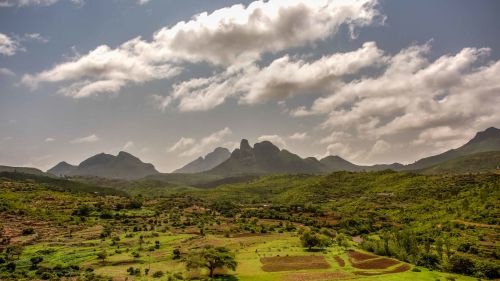Our New Gordian Knot

Roger Thurow examines the question of how to conquer global hunger and malnutrition while also saving the planet from the strain on our environment, biodiversity, and health.
The Nobel Prize Committee created a neat historical arc last week when it awarded the Peace Prize to the United Nations’ World Food Program for combating hunger and malnutrition in this time of Covid and conflict. Fifty years earlier, almost to the day, the Nobel Peace Prize was bestowed upon Norman Borlaug, an agricultural scientist, for engineering the Green Revolution and diffusing a grave threat to humanity by accelerating the pace of food production ahead of population growth, saving countless lives from starvation.
In 1970, the Nobel Committee proclaimed: “The world has been oscillating between fears of two catastrophes: the population explosion and the atom bomb. Both pose a mortal threat. In this intolerable situation, with the menace of doomsday hanging over us, Dr. Borlaug comes onto the stage and cuts the Gordian knot. He has given us a well-founded hope, an alternative of peace and of life—the Green Revolution.” Borlaug, the committee said, had “turned pessimism into optimism in the dramatic race between population explosion and our production of food.”
A half-century later, hunger and malnutrition still persist in our world, with the numbers growing daily during the disruptions of the pandemic—thus the continued need for the valiant efforts of the WFP. And yet again a Gordian knot (a complex, seemingly unsolvable problem) hangs over us, this one born, in part, from the success of the Green Revolution.
Now the dramatic race is between two of our most-pressing challenges: nourishing the planet and preserving the planet. How can we produce enough food to properly nourish an ever-growing and ever-more prosperous population—and finally conquer global hunger and malnutrition – while at the same time saving the planet from the consequences of those agricultural actions that strain our environment, biodiversity, and health? As each year goes by, it seems these two challenges are on a collision course.
The new fear is not that we will run out of food, but that we are dooming ourselves and our planet by the way we grow food. The essence of today’s challenge lies not in how much we grow (the mission of the Green Revolution), but what we grow and how we grow it to satisfy shifting diets and meet the daily nutritional needs for proteins, vitamins, and minerals crucial for healthy individual and societal development. We look to agriculture to be our salvation, but without mitigating and reversing its impact on our planet might it also be our ruination?
The Green Revolution’s primary focus on increasing agriculture production conquered famine in India and Pakistan and elsewhere in Asia where starvation was immense and unrelenting for decades. Progress on the agriculture front, propelled by advances in science, technology, research, and investments, helped to shrink global levels of extreme poverty by raising farmer incomes and reducing hunger.
All the while, though, our new Gordian knot was forming. The imperative to produce ever-larger quantities of food led to the creation of a food system that has heavily relied on a small number of crops and supporting agriculture systems, most of them optimized to provide cheap calories for both humans and livestock. Today, three-quarters of the world’s food is generated from only a dozen plants and five animal species. This monocropping of fields has made the global food system vulnerable to pests and disease; it has sapped the soils of nutrients and plowed under environmental biodiversity. The headlong push to increase yields depleted vital water systems; thicker application of fertilizer and pesticides introduced new pollutants to our soils, waters and air; deforestation to clear more land for crops and cattle accelerated around the world. Agriculture now rivals the energy and manufacturing sectors as the largest emitter of destructive greenhouse gases, which contribute to climate change.
In the push to increase harvests, agriculture unleashed forces that now threaten that very goal. Those greenhouse gases released by agriculture activities are now profoundly impacting agricultural production: lowering yields, weakening crop nutrients, altering the geography of farming. The resulting commodity shortages, price increases, and population migration have contributed to political and social unrest. Similarly, while one-third of the food we eat depends on pollination, agriculture’s monocropping and pesticide use has contributed to the collapse of pollinator colonies around the world.
Even before the pandemic, the UN’s Food and Agriculture Organization estimated that more than 820 million people were chronically hungry. The food system’s focus on calories and ultra-processed products relegated nutrition to an afterthought; as a result, micronutrient deficiency, a lack of crucial vitamins and minerals known as “hidden hunger”, afflicts about two billion people. Nearly one in every four children under the age of five is stunted, either physically or mentally, from early childhood malnutrition, leading to a life sentence of underachievement. At the same time, another two billion people are overweight or obese, and their number is rising as well, as is the incidence of diet-related non-communicable diseases. Poor diets are now a leading cause of deaths globally.
Our planet’s health has also become increasingly imperiled. Average global temperatures are rising. Polar ice caps and glaciers are melting at a quickening pace. Deforestation continues unabated. Coral reefs and other water habitats are deteriorating from all manner of pollutants; our throw-away habits of household, farm, and industrial products have degraded natural environments and endangered biodiversity all around us. One million species of plants and animals are said to face extinction in coming decades.
To cut our 21st Century Gordian knot will require the engineering of a new, far more complex revolution. We will need to forge a fresh era of human cooperation that unites a shared concern for agriculture, nutrition, environment, climate and biodiversity and the good health of humans, animals, plants, insects, soil, water, and air—as well as fostering a universal concern for justice and equality.
Attempts to construct this new movement—often called Planetary Health or One Health—are gaining urgency and momentum. Last year, I participated in one such effort called the Giant Leaps program. Leaders in farming, agriculture science, nutrition, conservation, economics, ethics, and governance gathered at Purdue University, hosted by its Center for Global Food Security led by Gebisa Ejeta, who won the World Food Prize for his pioneering work on sorghum production. The task ahead, he told them, is not solely a matter of science and technology but also of equity, for global food insecurity is tightly linked with poverty, gender imbalance, and the unequal distribution of global wealth, resources, and knowledge. Food is a fundamental need of all human society, and yet advances that have led to more food being produced than ever before haven’t been able to eliminate hunger and malnutrition from our world.
Part of the solution, the gathering determined, will be attaining important goals that are currently crucial in the rising economies of the developing world: investing in women farmers as well as men; enhancing agricultural-based businesses for gainful employment, particularly for the rural youth; equitably deploying research and scientific advances in the fields; and, increasing the efficiency of production, processing, distribution and utilization of nutritious food. All this, as well as nurturing healthy soils, preserving water, and broadening crop diversity, especially reversing the neglect of indigenous crops that played a vital role in nourishing populations for generations.
Success will also require creating an even greater appreciation and respect for nature, local ecologies, and social values—where farmers and conservationists are no longer bitter foes but allies, heroes in each other’s eyes rather than villains.
“Human society in the past has shown that it can achieve extraordinary feats and solve big societal problems when it builds sufficient common resolve and will,” Gebisa Ejeta challenged the gathering. “Can it now build one such global resolve as a last-ditch effort to eradicate hunger from the face of the earth? And save the planet at the same time?”
Several months later, I was in Ethiopia, Gebisa’s homeland, and there on a humble homestead on the side of a narrow dirt road, I saw his vision come to life. Abebe Moliso, a tall, slender farmer in his mid-40s, was tending a veritable Garden of Eden.
On nearly four acres, he was growing beans, peas, potatoes, sweet potatoes, peppers, barley, teff, coffee, and corn. On the edges of his fields were all manner of fruit trees: mango, avocado, papaya, apple, banana. Carrots, cabbage, beets, tomatoes and other vegetables flourished in garden patches tended by his wife Tsehainesh Desalegn and other women of the village. A dozen cows grazed on tall grass near a stream.
It was a remarkable transformation from two decades earlier, when Abebe and his family were dependent on international food aid distributed by the World Food Program. When I first visited this area, in the lakes region of Ethiopia’s Rift Valley, in 2003, two disasters—one humanitarian, one environmental—were exploding. Nearly 14 million people nationwide were receiving food aid in the world’s first famine of the 21st century. One of the causes was that vast stretches of land had become a moonscape of denuded hills, deep gullies, and eerie sand-and-dirt sculptures shaped by wind and erosion over the years. The soils were so degraded by decades of farming, cattle grazing, and deforestation that growing crops had become futile.
As the WFP distributed aid to the suffering people it also began a program to heal the suffering land. Farmers, including Abebe, left their land fallow for several years. Instead, they dug trenches and pans to collect and conserve the rainwater, and they constructed terraces and planted grasses and trees to slow the erosion and naturally return nutrients to the soil.
It worked for large swathes of land. When I returned to this area 16 years later, I found that the productivity of denuded plateaus and hillsides had been restored. Forests returned, underground springs poked through the surface to form wells and ponds, and insects, pollinators, birds and animals were back.
And so were the farmers and their crops. “This land was dead, nothing would grow, and now look,” said Abebe, opening wide his arms to embrace his thriving fields. He deployed all he had learned while his land healed. He formed terraces, planted cover crops to shield his soil from evaporation and erosion, developed a composting system for fertilizer, adopted conservation farming techniques that minimized soil disruption, planted trees that would provide shade and fix nutrients in the soil and bushes that produced natural pesticides, and he began a crop rotation that would allow the soil to refresh from season to season.
No longer would he plant row after row of corn year after year, as was common practice. “Why would I do that?” he said. “No, no. No more. Now I have crops coming ripe all year long. If one fails, another succeeds. We have a steady flow of food and income.” Diversification, he tells his neighbors, is the way to go.
He seeks to both nourish his family and preserve his land. He is one farmer taking a swipe at our Gordian knot. “God gave me an open mind to learn,” he said. “And I hope I can open the minds of others."

